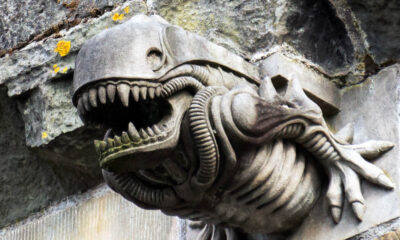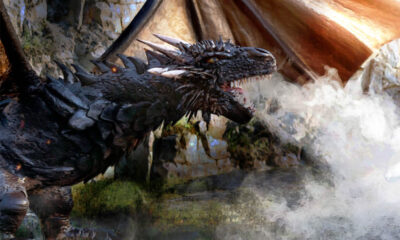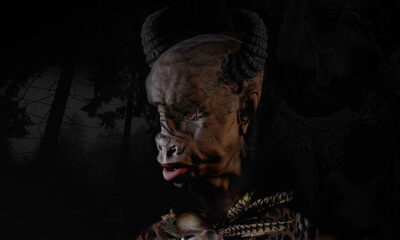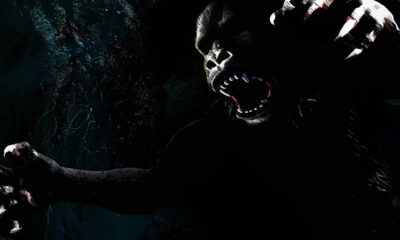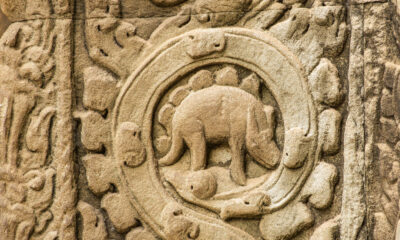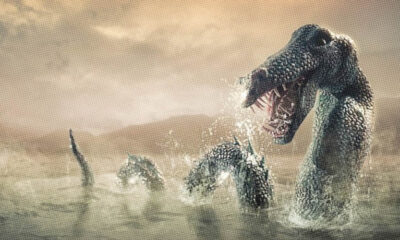Cryptids
Chupacabra Facts: 10 things you need to Know!
If you’re looking for Chupacabra facts then the legend begins in Puerto Rico, a densely wooded island in the Caribbean located south east of Cuba and adjacent to Haiti.

Chupacabra Facts – 10 Things you need to know!
The concept of the Chupacabra is not new – only the name is. Since humans established permanent Neolithic farming settlements and started the process of domesticating animals, (Circa: 10,000bc) their livestock has been attacked by predators. Many of these are now extinct but once included the sabre tooth family of felines, the enormous Short Faced Bear and much more recently – the Tasmanian tiger. There are probably many more that have not made it into the historical and archaeological record.
1. THE CHUPACABRA LEGEND BEGINS
The Chupacabra legend begins in Puerto Rico, a densely wooded island in the Caribbean located south east of Cuba and adjacent to Haiti. The attacks that brought the Chupacabra to the attention of the world took place around the Puerto Rican town of Moca on the western side of the Island in 1975. These were blamed on The Vampire of Moca, (El Vampiro) but later attributed to the Chupacabra. The name of El Vampiro was originally used because all the animals killed had been fully drained of blood. Over time, the attacks became infrequent and were almost forgotten.
2. THE ATTACKS RESUME
During the period between1992 and 1995 a spate of attacks on animals occurred around the Eastern half of the island. So frequent were these incidents happening that Puerto Rican newspapers El Vocero and El Nuevo Dia regularly began to report the killings. As yet no single creature was suggested as the culprit, but the attacks were identical to those that had occurred at Moca in 1975. (It is worth noting that both these newspapers had a reputation, at this time, for focusing on the sensational.) It is fair to say that even from the start there was scepticism amongst the more educated levels of Puerto Rican society who attributed the killings to stray dogs which were a serious problem at that time.
3. NAMING THE BEAST
Although the creature (or creatures) now called Chupacabra may have existed for millennia, they came into mainstream awareness after a series of peculiar attacks on livestock in and around several Puerto Rican towns and especially near to the village of Canóvanas during the months leading up to October 1995. The beast seemed to actively target goats and when the bodies were found they, like those of Moca, had been drained of blood. It didn’t take long for the locals to start calling it ’El Chupa Cabra’ or literally translated – The Sucker of Goats. The name stuck and was soon being quoted in the media.
4. THE FIRST EYEWITNESS DESCRIPTIONS
It is believed that the first description of the creature was provided by Michael Negron, 25, who discovered an agile, erect, two-legged creature hopping animatedly in the dirt outside his house.
“It (the Chupacabra) was about three or four feet tall, with skin like that of a dinosaur,” he said. “It had eyes the size of hens’ eggs, long fangs, and multicoloured spikes down its head and back. “
During this time other people saw a similar creature and a clearer picture of the beast emerged.

when it comes to Chupacabra facts the “original” beast of popular and more recent reporting is a mysterious creature that is described as being about 3ft (36 inches) tall and has aspects of its appearance that are distinctly reptilian such as flaking scales and short spines protruding at intervals along the length of its backbone. However, its skin is said to be leathery and mottled purple and black. The hind quarters of animal somewhat resemble those of a kangaroo and people that have reported seeing it claim that it can leap fair distances. Facially it has the snout of a canine predator but with a huge mouth equipped with two distinctive “sabre” teeth. Its eyes are said to glow orange or red. Some reports add that it has a forked tongue and will make hissing and screeching sounds. Its scent, which is apparently strong, is fetid and faecal in nature (not sulphuric as is often reported). Reports claim that it is also capable of walking on its hind legs.
5. THE FIRST OFFICIAL HUNT
It was apparently during August of 1995 that a major attack occurred in Canóvanas itself and resulted in the death of approximately 150 animals. It is worth noting that the town of Canóvanas is only 5.5 miles from the border of the El Yunque National Forest of Puerto Rico. It is the only tropical rainforest of the USA and is 28,000 acres in size. The majority of the very first official Chupacabra sightings and animal attacks were located near to this “preserve”.

Chupacabra Facts – Newspaper Scan
The first executive search for the Chupacabra was organised on the 29th of October 1995 by the Mayor of Canóvanas, Jose “Chemo” Soto, and repeated at regular intervals. Several of the hunters claimed to have shot at a creature but no actual body was found.
6. CHUPACABRA FACTS: MEDIA HEADLINES
As the animal attacks continued the story started to become more important to the media and the Daily Courier of Yavapi County, Arizona, ran a commentary on the 21st of November 1995 entitled: Goatsucker: Puerto Rican Vampire – Animal Deaths Remain Mystery.
0n the 8th of January 1996 APTV ran a detailed story including video interviews and pictures of the tracks left by the creature. A description of the injuries differs from many of those described elsewhere on the internet. However, this is clearly one of the original sources. Title: Puerto Rico: Mysterious Creature Terrorizes Countryside. Summary: Story No: 20630Date: 1/8/1996 5:00:00 AM Source: APTV. A quote from the article reads:
“Eyewitnesses accounts differ as to what the creature looks like, but they all agree that it attacks at night, bites its victims in the throat and sucks them dry. Local veterinarians say in each of the cases studied the cause of death were two deep puncture wounds under the right side of the neck. The wounds were about the diameter of a drinking straw and three to four inches in length. Experts say the wounds are not compatible with the bite of a dog, a monkey or any other carnivore. Police are taking the reports very seriously because of the great number of sheep and cattle lost, but they say they have no idea what kind of creature is responsible. Some witnesses claim there’s more than one roaming around the island. They say they resemble some type of ape.
From a sound-bite originally in Spanish: “They are two big animals, as big as a man. I saw them from afar, they looked like big apes, but I couldn’t distinguish their features.”
The full video report is available at: http://www.aparchive.com. Search for the story number.
By the 24th of January 1996 the Chupacabra was a big enough story to make it into the mainstream media and in particular the “Inter Press Service English News Wire” which ran the story: Puerto Rico: Vampire Monkeys Seize the Spotlight.
A quote from the article reads: “Seemingly from out of nowhere, a new figure has erupted in Puerto Rico’s national mythology — the ‘Chupacabra,’ a vicious monkey that can run upright on its legs, slaughter goats and suck the blood from its prey.”
Radio stations and other media in Puerto Rico had already been reporting the attacks but as the various news announcers started referring to the creature as the Chupacabra the story could focus on a single name that people could relate to. The result was the spread of low-grade mass hysteria and soon any kind of attack on any animal was the work of the Chupacabra! This phenomenon is common and well recorded.
7. COMING TO AMERICA
By May 1996 reports of strange animal attacks were being reported on the mainland of America. CNN ran a story entitled: Monster (the Chupacabra) accused of killing farm animals in Florida.
“Ever since the death of more than two dozen goats, chickens, and geese last week, residents (mainly Hispanic) of the Miami suburb of Sweetwater have whispered the name of what they say is the killer … Chupacabra.“
Since this time there have been literally hundreds of reports relating to the Chupacabra from Arizona (USA) to Bolivia. In almost all of these cases the actual wounds inflicted do not match the original findings of the Puerto Rican veterinarians
Again, news reports about the events were often written before the scientists had a chance to examine the bodies. (Headlines such as: “Dog Attacks Chickens” is unlikely to sell many newspapers. However, “Chupacabra Massacre in Stupidville” probably will.
8. CHUPACABRA ARE NOT HAIRLESS COYOTES OR DOGS
Naturally, and unfortunately, every self-proclaimed paranormal expert seems to have jumped onto the Chupacabra bandwagon and added their own exaggerations. Some claim it’s an alien – probably inspired by the 1987 film “Predator” about a somewhat similar creature living in the central South American jungles. Some claim it’s a living dinosaur. Others even claim it’s a giant mutant vampire bat.
There have even been claims by people that they have filmed, captured or killed a Chupacabra (Even kept its head in the freezer.) Again, to the best of our knowledge, these claims have turned out to be false. The most recent “sensationalist” reports relating to the Chupacabra originate from the town of Cuero in Texas (USA)

Chupacabra Facts – Hairless Peruvian Dog – By Paradais Sphynx – Own work, CC BY-SA 3.0, https://commons.wikimedia.org/w/index.php?curid=30279012.
Yet again, the attacks have almost no resemblance to the original Puerto Rican events when scientifically scrutinised and it is now widely believed that the animals captured are coyotes suffering from a “mange-related disease” that seems to be prevalent in the area.
9. FEATURED ON THE X-FILES
A version of the Chupacabra was featured on the hit 90’s TV series – The X-files. Entitled: El Mundo Gira it was watched initially by 27 million people and by now that number is estimated to be well over 100 million. The programme was aired first in 1997, just after the second wave of attacks occurred in Puerto Rico. However, in this version, the Chupacabra is linked to aliens and a mysterious fungus. This opened the door to the idea that the Chupacabra could be an alien or a diseased human, maybe animal. However, this was not the Chupacabra described by witnesses in Puerto Rico.
10. DEBUNKING OLD LADIES IS A SOFT TARGET
Various researchers have tried to track down the Chupacabra with little success. One even concluded that one of the first witnesses had been influenced by the film ‘Species’ which features a vaguely similar creature and had recently been released. In particular, one woman admitted she had recently seen the film and after that the researcher gave up and went home. Perhaps she had been influenced by the movie but, in reality, her description was quite different for ‘Sil’ the hybrid monster in the film.
BEYOND THE HYSTERIA
There is a fairly plausible theory that the Chupacabra is actually a large monkey or ape of some kind with a skin disease. Possibly it was native to the jungle of El Yunque National Forest, or more likely introduced from Africa. Desperate and ill it took to attacking local livestock for food. A hairless chimp or Mandrill would fit the description quite well. Equally, it is possible that the creature is something else altogether more paranormal.
Unfortunately, the Chupacabra has been so thoroughly adopted by all forms of media that the true mystery has been lost. It has featured in thousands of online articles (often copying each other without any serious research), in films, TV programmes and the printed media from books to magazines. However, very few of these actually investigate the Puerto Rican events that took place between 1992 and 1997.



